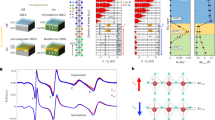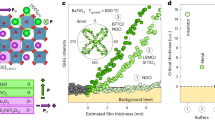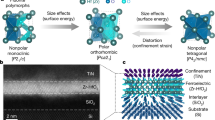Abstract
It is generally accepted that magnetic order in an insulator requires the cation to have partially filled shells of d or f electrons. Here we show that thin films of hafnium dioxide (HfO2), an insulating oxide better known as a dielectric layer for nanoscale electronic devices, can be ferromagnetic even without doping. This discovery challenges our understanding of magnetism in insulators, because neither Hf4+ nor O2− are magnetic ions and the d and f shells of the Hf4+ ion are either empty or full.
Similar content being viewed by others
Main
The electronic spins of cations in insulating oxides are normally coupled by nearest-neighbour interactions — either superexchange or double exchange1. No long-range magnetic order is anticipated below the percolation threshold, because there is no extended network of neighbouring sites occupied by magnetic ions. Controversy has therefore surrounded reports of high-temperature ferromagnetism in thin films of transparent, wide-bandgap oxides, such as zinc oxide, titanium dioxide or tin dioxide, that have been doped with a few per cent of a 3d cation such as V3+, Mn2+, Fe3+ or Co2+ (ref. 2). The moments in these ferromagnets, which may be insulating or conducting, are sometimes too large to be explained by any impurity phase. An indirect exchange mechanism involving donor electrons in a spin-split impurity band has been proposed for such materials having a high dielectric constant (our unpublished results).
The Hf4+ ion has a closed shell [Xe]4f14 configuration, with no unpaired electrons. We deposited thin films of hafnium dioxide by conventional pulsed-laser deposition from a sintered target on to substrates maintained at 750 °C. The target was 99.95% pure, with zirconium as the main metallic impurity. Iron, cobalt and nickel were below 10−2 wt%. Substrates were sapphire or silicon. The excimer laser wavelength and fluence were 248 nm and 1.8 J cm−2, respectively. Oxygen pressure during deposition was varied from 10−4 to 1 millibar. Films were 45–135 nm thick, transparent, colourless and insulating; in a typical film, the c-planes of the monoclinic hafnium dioxide structure were oriented parallel to the surface of the R-cut sapphire substrate.
These films are ferromagnetic, with a Curie temperature exceeding 500 K and a magnetic moment of about 0.15 bohr magnetons per HfO2 formula unit (Fig. 1). The magnetization is remarkably anisotropic, being up to three times greater when the magnetic field is applied perpendicularly to the plane of the film than when it is applied in the parallel direction. Coercivity at 5 K was about 5 millitesla. Results were reproduced in films of different thicknesses prepared at different oxygen pressures and on different substrates. No ferromagnetism was found in similarly prepared films of zinc or tin oxides.
These room-temperature data are corrected for background diamagnetism of the substrate (−1.8 × 10−7 A m2 T−1). Insets: top left, proposed coupling scheme for orbital, spin and impurity-band magnetism in hafnium dioxide (blue circles represent electrons, arrows show direction of their spin moment, the orbital and spin moments l and s of an electron in a 5d state couple antiparallel to form a j = 3/2 state); bottom right, magnetization curves at different temperatures (triangles, 5 K; circles, 400 K).
These results confound our understanding of magnetism in solids. What in hafnium dioxide could possibly be magnetic? Lattice defects may be the key. In view of the preparation conditions, oxygen vacancies may be expected3, leading to n-type doping of the material. The electrons associated with defects in oxides having a high dielectric constant occupy large Bohr orbitals and tend to form an impurity band where they may be localized by correlations and local potential fluctuations4 to give the observed insulating behaviour. By allowing the impurity band to mix with the empty 5d states of hafnium and to transfer a fraction of an electron for each vacancy, the 5d states would in turn polarize the impurity band and provide the necessary ferromagnetic coupling. The anisotropy suggests a large orbital contribution to the 5d moment, with electrons in a spin-orbit coupled j = 3/2 state (Fig. 1, top-left inset).
Whatever the explanation, our discovery of anisotropic high-temperature d0 ferromagnetism in a transparent oxide is challenging for the theory of magnetism and propitious for the future of spin electronics, provided that the spin-polarized electrons can be mobilized.
References
Goodenough, J. B. Magnetism and the Chemical Bond (Interscience, New York, 1963).
Prellier, W., Fouchet, A. & Mercey, B. J. Phys. Cond. Mat. 15, R1583–R1601 (2003).
Foster, A. S., Lopez-Gejo, F., Shluger, A. L. & Nieminen, R. M. Phys. Rev. B 65, 174117 (2002).
Mott, N. F. Conduction in Noncrystalline Materials (Clarendon, Oxford, 1987).
Author information
Authors and Affiliations
Corresponding author
Ethics declarations
Competing interests
The authors declare no competing financial interests.
Rights and permissions
About this article
Cite this article
Venkatesan, M., Fitzgerald, C. & Coey, J. Unexpected magnetism in a dielectric oxide. Nature 430, 630 (2004). https://doi.org/10.1038/430630a
Published:
Issue Date:
DOI: https://doi.org/10.1038/430630a
This article is cited by
-
Vacancy-mediated anomalous phononic and electronic transport in defective half-Heusler ZrNiBi
Nature Communications (2023)
-
Defects mediated weak ferromagnetism in Zn1−yCyO (0.00 ≤ y ≤ 0.10) nanorods semiconductors for spintronics applications
Scientific Reports (2023)
-
Impact of Sb/Ag co-doping on SnO2’s optical, transport, and crystallographic properties for optoelectronic devices
Journal of Materials Science: Materials in Electronics (2023)
-
Growth Technique–Induced Highly C-Axis-Oriented ZnO: Mn, Zno: Fe and ZnO: Co Thin Films: A Comparison of Nanostructure, Surface Morphology, Optical Band Gap, and Room Temperature Ferromagnetism
Journal of Superconductivity and Novel Magnetism (2023)
-
Room temperature ferromagnetism in metal oxides for spintronics: a comprehensive review
Optical and Quantum Electronics (2023)
Comments
By submitting a comment you agree to abide by our Terms and Community Guidelines. If you find something abusive or that does not comply with our terms or guidelines please flag it as inappropriate.




